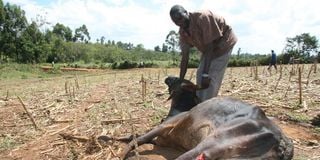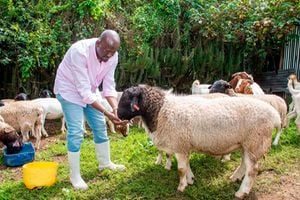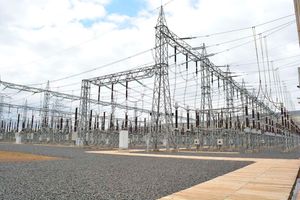
A man examines an injured cow in this picture taken on December 2009.
The best way to deal with injuries in cattle is to avoid them. It is, however, not possible to prevent injuries at all times, especially where a farmer has not taken time to understand cattle welfare.
A majority of farmers build cattle management facilities without considering and understanding welfare.
It is only after they start operating the facilities that they realise more thought and expert consultation should have gone into construction.
Cattle management structures include fences, loading and off-loading ramps, parasite control units such as dips and spray races, paddocks, houses and handling crashes.
Open and semi-open grazing fences are the most common management structures. Farmers make such facilities as holding and grazing paddocks, lanes and restraint for cattle to access forbidden areas like homesteads or crop farms.
Fences also provide safety for animals. They shield cattle from dangerous features like water bodies, holes, steep grounds and cliffs.
The interaction of cattle with management facilities, other cattle, animals and humans inevitably results in injuries to the animals.
The injuries should be few but when they occur, the farmer has to decide if they should be treated or the animal should be culled.
In many cases, the farmer gets advice on the course of action from an animal health service provider.
Loss of lower hind leg
Some farmers make the decisions independently when they are convinced that they understand the chances of the animal recovering.
With experience, farmers are able to recognise injuries in which the cattle should be eliminated by slaughter or mercy killing. The decision on whether to terminate or save the life of an injured cow depends on several factors.
If the farmer believes the extent or depth of the injury would make the animal unproductive even after healing or that it would be costly, the animal is terminated.
I recall a rare case where a cow had lost its lower hind leg but the owners were unwilling to have it slaughtered.
Though it was a high-yielding Friesian, the consideration of the owners was sentimental rather than commercial.
The three owners had been given the cow by their late grandmother, after whom they had named the animal after. It had also given them four good heifers.
The cow had got its leg trapped in a narrow deep hole on hard ground. The leg had broke in the attempts of the animal to free itself.
It is always good to inspect spaces regularly, identify and remove hazards or fence them off to prevent their interaction with the animals.
From the position of the injury, midway between the hock and hoof joints, it would have been difficult for the animal to live comfortably with the truncated leg.
The options were to fix an artificial leg addition or amputate the leg higher up.
Since the cow was about 650 kilos, the remaining hind leg would still have ended up with overloading and lameness.
Fortunately, the owners eventually agreed to my recommendation that they sell it for slaughter. They mourned their beloved Wanjiru.
Most injuries in cattle can be treated with various degrees of complexity, depending on the location of the wound and depth into the tissues.
Almost all cut injuries that do not penetrate into the body cavities can be treated by closure using sutures or surgical threads.
Injuries to external organs like the eyes, teats, udder and ears may be treated with surgical repair or removal of the organ as long as the removal would not seriously impair the cow’s production or greatly lower its comfort in life.
Last week, a farmer asked me by phone if the teat of his cow could be surgically repaired.
It had been cut by barbed wire and milk was seeping through the wound. I told him the opening could be closed but he needed to seek the services of a veterinary surgeon.
Closing a full thickness teat cut is delicate. The the doctor has to use thin absorbable suture No.6/0 to close the inner teat lining in a way that milk cannot seep through.
Tail fracture
The doctor must take great care to ensure the wound does not heal into the teat canal and cause blockage to the flow of milk.
Done properly, the cow survives the injury and continues being productive.
The most common cause of cow injuries in modern farming are fence fixtures like barbed wire, sharp rough edges of metal and wood and sharp protruding objects like nails and pieces of metal.
Farmers should regularly inspect their fences and walls of structures to ensure there are no offensive objects.
Structures that may trap animals’ legs, tails and necks should be identified and removed from the environment.
Tail fractures mostly end up with amputation. A cow with an amputated tail is uncomfortable as the organ is mainly used for maintaining balance and fending off flies and birds.
Some birds peck on wounds on the skin of cattle, especially for animals in open grazing.
Most cows with leg fractures have to be terminated because it is difficult to avoid placing weight on a fractured leg. Cattle below six months of age may heal a fracture on a leg, unlike adults.









